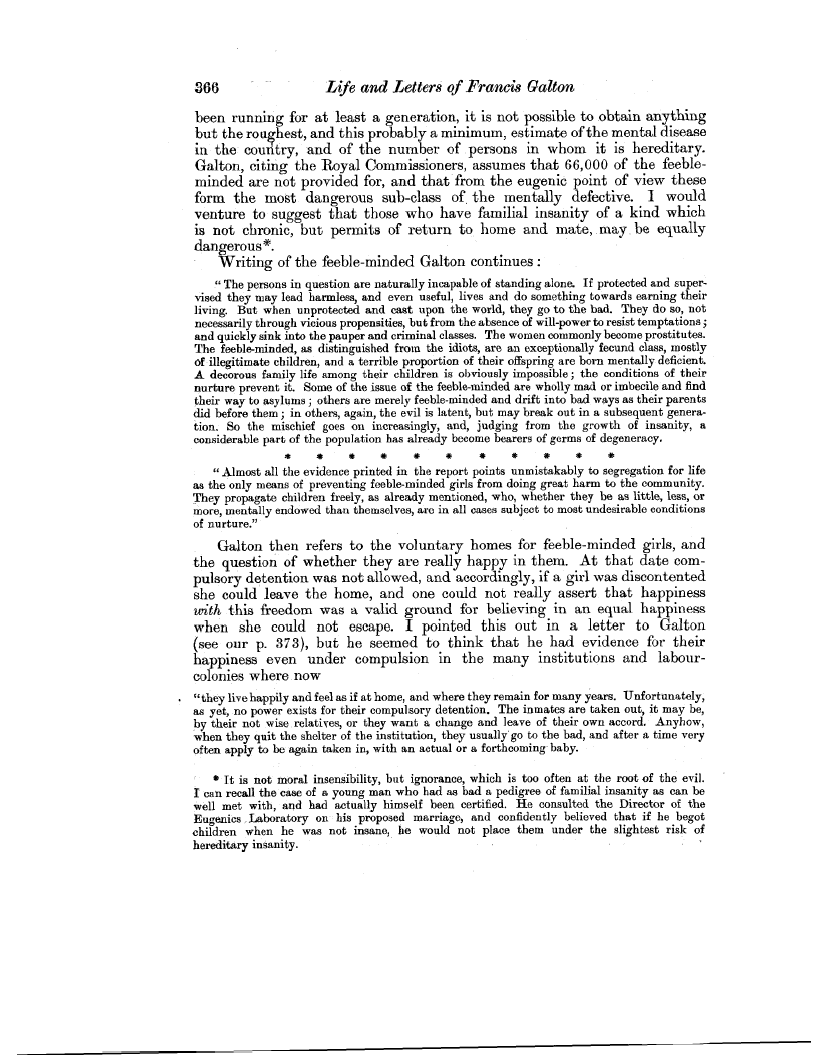| ||||||

OCR Rendition - approximate
366 Life and Letters of Francis Galton been running for at least a generation, it is not possible to .obtain anything but the roughest, and this probably a minimum, estimate of the mental disease in the country, and of the number of persons in whom it is hereditary. Galton, citing the Royal Commissioners, assumes that 66,000 of the feebleminded are not provided for, and that from the eugenic point of view these form the most dangerous sub-class of. the mentally defective. I would venture to suggest that those who have familial insanity of a kind which is not chronic, but permits of return to home and mate,. may, be equally dangerous*. Writing of the feeble-minded Galton continues " The persons in question are naturally incapable of standing alone. If protected and supervised they may lead harmless, and even useful, lives and do something towards earning their living. But when unprotected and cast upon the world, they go to the bad. They do so, not necessarily through vicious propensities, but from the absence of will-power to resist temptations ; and quickly sink into the pauper and criminal classes. The women commonly become prostitutes. The feeble-minded, as distinguished from the idiots, are an exceptionally fecund class, mostly of illegitimate children, and a terrible proportion of their offspring are born mentally deficient. A decorous family life among their children is obviously impossible; the conditions of their nurture prevent it. Some of the issue of the feeble-minded are wholly mad or imbecile and find their way to asylums ; others are merely feeble-minded and drift into bad ways as their parents did before them ; in others, again, the evil is latent, but may break out in a subsequent generation. So the mischief goes on increasingly, and, judging from the growth of insanity, a considerable part of the population has already become bearers of germs of degeneracy. "Almost all the evidence printed in the report points unmistakably to segregation for life as the only means of preventing feeble-minded girls from doing great harm to the community. They propagate children freely, as already mentioned, who, whether they be as little, less, or more, mentally endowed than themselves, are in all cases subject to most undesirable conditions of nurture." Galton then refers to the voluntary homes for feeble-minded girls, and the question of whether they are really happy in them. At that date compulsory detention was not allowed, and accordingly, if a girl was discontented she could leave the home, and one could not really assert that happiness with this freedom was a valid ground for believing in an equal happiness when she could not escape. I pointed this out in a letter to Galton (see our p. 373), but he seemed to think that he had evidence for their happiness even under compulsion in the many institutions and labourcolonies where now "they live happily and feel as if at home, and where they remain for many years. Unfortunately, as yet, no power exists for their compulsory detention. The inmates are taken out, it may be, by their not wise relatives, or they want a change and leave of their own accord. Anyhow, when they quit the shelter of the institution, they usually' go to the bad, and after a time very often apply to be again taken in, with an actual or a forthcoming baby. It is not moral insensibility, but ignorance, which is too often at the root of the evil. I can recall the case of a young man who had as bad a pedigree of familial insanity as can be well met with, and had actually himself been certified. He consulted the Director of the Eugenics Laboratory on his proposed marriage, and confidently believed that if he begot children when he was not insane, he would not place them under the slightest risk of hereditary insanity.
|